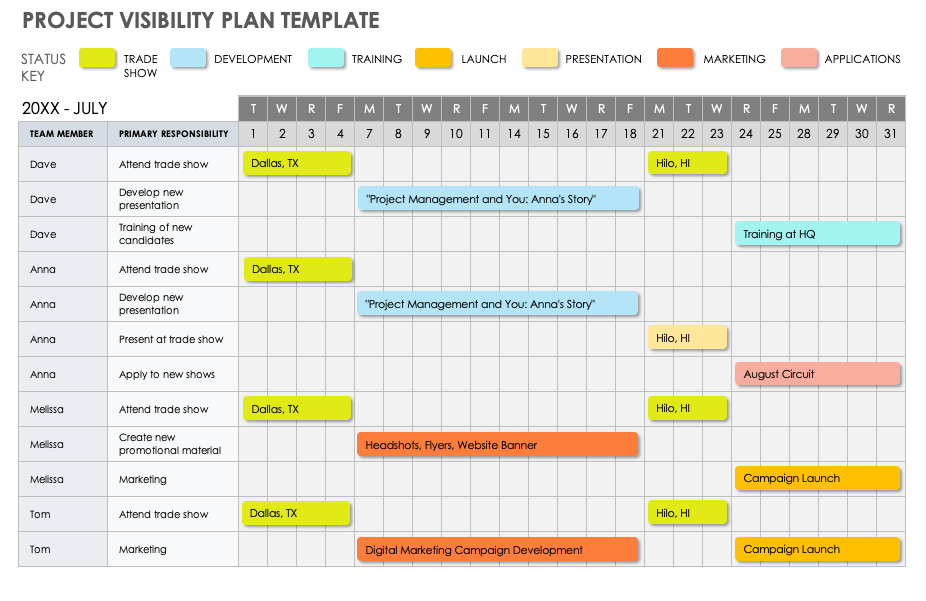What Is Project Visibility?
The term project visibility refers to the big-picture view of a project. Clear visibility makes it easy to see the task status and progression, the team’s current and next steps, and any potential risks.
Project visibility also has far-reaching implications for the culture of a business environment. A culture of visibility tends to reflect a business with teams that are communicative, engaged, and empowered to share their expertise with others.
Four Components of Project Visibility
In general, project visibility includes four critical aspects, as follows:
- Project Goals: Define your project goals and share them with the team. Use these goals as signposts for the rest of your project and reference them often to keep your team on track.
- Visual Status Reporting: Along with written updates, a visual dashboard or chart helps users understand project status more easily. Create a document or dashboard that the team can reference at a glance, and update it in real time to reflect the status of your project. It often helps to grant team members editing access, so they can adjust and update their own status.
- Individual Team Members’ Responsibilities: An effective project manager excels at delegating. Know the strengths of your team and its individual members, and communicate clearly about individual responsibilities and the expectations of the team as a whole. Make these assignments visible to everyone on the dashboard.
- Any Potential Risks: As with any project, risks are always inherent. By clearly outlining the potential risks of a project, you can often avoid them entirely. And by making these potential risks public, you put more eyes on the issues that may arise, which means more chances to notice and correct them before they occur.
Project Management Guide
Your one-stop shop for everything project management

Ready to get more out of your project management efforts? Visit our comprehensive project management guide for tips, best practices, and free resources to manage your work more effectively.
What Is Project Transparency?
Project transparency is the idea that any person interested in reviewing a project’s goals and status can do so. By making your project transparent, you encourage early and more complete investment from all members of the team.
“Visibility on open tasks and assigned ownership is the key piece of transparency that keeps things moving and ensures employees deliver tasks on time,” says Jordan Witt, Solutions Architect at CentralSquare Technologies. “In my case as an individual contributor, all of my requests are handled through a CRM/queue where work is tracked and assigned, and this ensures nothing falls through the cracks that's handled via phone or email. The paper trail generated by project tools and their visibility ensures transparency and accountability.”
Project Transparency vs. Project Visibility
A project can be visible without being transparent when you prioritize some team members over others and give them access to more or different information. A transparent project will offer all information to every team member, regardless of their level.
You can think of transparency as the highest level of visibility. When records, conversations, or information is not accessible to everyone, you muddy the transparency of a project.
The Importance of Project Visibility
Effective project visibility is essential for fostering cohesive teams within an institution. Project visibility encourages more productive teamwork, eases communication, and optimizes and encourages best practices. These results often bring about increased quality and timeliness of deliverables as well.
Benefits of Project Visibility
Increased visibility has many benefits, including improved communication, organization, and understanding between managers and team members. Below are several advantages that project visibility can deliver for your organization:
- Improve Communication: The most obvious and immediate benefit of visibility is improved communication among all project stakeholders. When communication is open and honest from the outset, everyone benefits.
- Build Trust with Stakeholders: Stakeholders appreciate being in the know. Instead of waiting for updates or asking questions, clients and executives should have access to your dashboard in order to answer questions themselves.
- Organization: Creating and maintaining a central dashboard is a great way to encourage strong organizational practices for yourself and your team.
- Foster More Cohesive Teams: Visibility helps build trust by keeping communication above board and eliminating an air of secrecy. A team that feels involved in the entire process of a project is more likely to trust its members to get work done and make decisions that benefit everyone.
- Anticipate Risks: Outline risks at the outset and share that information with the group to catch problems early. Your team is more likely to avoid issues altogether when everyone understands the risks and feels empowered to address them.
- Encourage Feedback: Allow access to updates to encourage early feedback. Team members and stakeholders do not need to wait until they receive a project status report to comment on an aspect of the project if they can see updates throughout its lifecycle.
Who Relies on Project Visibility?
Everyone involved in a project relies on project visibility. While visibility efforts come primarily from the project manager, it is just as important for team members and stakeholders to strive for transparency in order to ensure that all information is accessible to everyone.
Witt shares that “transparent, open communication and collaboration is essential for inspiring workers to do quality work and be accountable for themselves and their line of business. [Accountability] helps build a trail [of actionability] if an issue comes up in the future.”
Team Members’ Roles in Providing Project Visibility
Team members are responsible for maintaining transparency in their communication and workflow, but they also need a good project manager to lead the charge. Create a communication plan and update it as needed. Encourage the use of visual communication mediums, such as notes in a shared timeline, instead of one-to-one methods such as email or instant messages. Individuals should also track their progress on tasks and mark them as complete.
Witt adds, “At the same time, good documentation, transparency, and visibility in the process are essential for onboarding new employees, who may feel overwhelmed when they come on board to a project environment, especially if the employee is expected to learn many specialized or niche products all at once. In some cases, it could take years for an employee to become fully up to speed in their job role, whereas proper visibility, transparency, and accountability can bring a new employee up to speed far faster.”
How to Achieve Project Visibility
While building project visibility is an ongoing process, below are concrete steps you can take:
- Create a Project Communication Plan: A solid project communication plan is a cornerstone of project visibility. When everyone knows to expect updates, meetings, and status reports, there is less confusion and fewer wasted hours.
- Send Status Reports: Create regular project status reports that anyone can access at any time. Send them to stakeholders, and archive them for reference by other teams on later projects.
- Encourage Open Communication: Encourage team members to communicate through a central platform, rather than through one-on-one methods such as email or IM. Many people will likely have the same or similar questions; asking and answering questions publicly helps save time so that you don’t have to address the same questions later.
- Hold Meetings (But Not Too Many): Schedule meetings as early as possible, and let everyone know what you will cover during the time. Face-to-face time is valuable, and you might find that you get more or different feedback in person than through text.
- Visualize Workflow: Create a central location or dashboard to visualize your progress. Consider using a Kanban board in your meeting room or digitally on your dashboard.
- Use Available Software: Many project management software solutions offer benefits such as a centralized status dashboard, open message board-style communication platforms, and organizational tools and charts. Use what you have before investing in new products.
Factors that Contribute to Lack of Project Visibility
Many common practices can contribute to a lack of project visibility, such as information tiers and general disorganization. We’ve collected some of the most common ones below and offer suggestions for overcoming them in the future:
- One-to-One Communication Methods: Email and IMs hide the information that is shared between two people. When someone asks a question, ensure that other people have that answer, too. Use an open, asynchronous tool such as a central message board or shared chat channel that everyone can access whenever they need to. To learn more, visit our comprehensive guide to asynchronous communication.
- Limited Access to Information: “A lack of visibility and collaboration between groups often leads to teams ‘siloing’ themselves into a specific knowledge set and not sharing information, which can lead to different groups within the company setting different standards and different methods to complete tasks and deliverables,” notes Witt. Make sure that all teams and team members have access to procedures and standards across the board.
- Not Clearly Defining and Stating Goals: People are less invested if they don’t understand the “why.” Let your whole team know the desired results of the project, and let them help you get there.
- Disorganization: Keep all of your status info organized and in one place. By placing notes and updates in different places and formats, you confuse everyone and waste time trying to find the info.
| Result of Lack of Project Visibility | How to Overcome |
|---|---|
| Answering the same basic questions over and over | Make communication visible. Share your communication plan with the team, and ask and answer all questions in a public forum. Consider making it searchable by keyword, if possible. |
| Team members aren’t engaging with the project | Include all team members in the development process. Make sure to clearly state your goals, and outline how the final result of the project will affect the team and the organization. |
| Encountering critical issues without enough time to intercept them | Be open about the risks and give your team an idea of what to look for. Encourage them to bring up potential roadblocks as soon as they recognize them. |
| Confusion about deadlines, deliverables, and workflow | Create a visual timeline that includes everyone’s deadlines and workflow. Keep the timeline up to date, and allow anyone access so that they can update their own or view others’ info. |
How to Measure Project Visibility
The best way to measure project visibility is against your own past projects. After you have improved visibility, compare the speed and quality of your deliverables from the last project at the same point in your current one.
Consider factors such as budget, adherence to deadlines, and the time-cost of frivolous tasks like answering the same question for five different people. Track your schedule variance as a baseline and compare it to your variance on projects after you have implemented enhanced project visibility. You can do the same with budgets by calculating your cost variance and comparing it at the same points across different projects.
Consider holding lessons learned meetings after your projects to more easily identify and track the results of improvement of visibility over time.
Expert Tips to Improve Project Visibility
We’ve asked the experts their best tips and tricks for improving project visibility. Read on to learn about the advantages of varied communication, visual progress trackers, and more.
- Project Management Software: Establish the use of project management software within your organization. Keep everything in one place. “I think my best advice is to use specialized tools to meet the task,” says Witt. “Whatever you're using, you should have a tool that is visible to all users on a project, allows assignments and ownership of work and key milestones, and enables you to set reminders and deadlines to ensure key goals are met on time. It should also be easy to go back and look at past projects to help review and be consistent with projects and deliverables.”
- Create a Communication Plan: A communication plan will help keep you and your team accountable for what needs to be communicated, to whom, and how often. For more information about communication plans, read “The Comprehensive Guide to Project Communication Plans.”
- Vary Your Communication Methods: Kristen Bellomo, Senior Project Manager at Bednark Studio, encourages frequent communication with the team and the client. She uses a combination of emails, phone calls, progress photos, and in-person meetings to ensure that her clients have an eye on every step of the process.
- Include Your Client: “Transparency isn't just for internal groups; being open with your customers about the timeframes and costs upfront help set the correct expectations down the road, where it can be much harder to try to recover,” notes Witt.
- Use Visual Aids: Patti Armanini, Quality Manager at Festo USA, emphasizes the benefits of visual tools like Gantt charts. She uses them to “track each individual’s progress, milestones, made and missed deadlines, and precursors that must be completed before a next step can take place.”
- Delegate Tasks: “If something is everyone's job, then it's no one's job. Tasks without owners and visibility and just assigned to ‘everyone’ are less likely to get done, the business version of the bystander effect in action,” warns Witt.
- Keep Communication Public: “All users on a project should have access to the tool where they can share and store project data, and projects should be able to split tasks to individual owners that will then go out to an individual or team contributors and, in the latter, to their respective team leader,” suggests Witt.
- Maintain Accountability: “‘Accountability’ isn't a scary word,” says Witt. “It's the end goal of transparency and visibility, and it helps ensure projects get done on time.”
Project Visibility Checklist
When starting a new project, you must consider visibility from the beginning. With help from Witt, we’ve created this checklist to help you stay organized and mindful of visibility from your project’s inception.
Project Visibility Plan
A project visibility plan is a tool to help organize the status of action items throughout the life of a project. Assign tasks to individuals with an estimate of the time needed to complete them, and update their status as time goes on. Customize any of our free project status templates for use in your own visibility plan.
A project visibility plan works hand in hand with a good project communication plan. With both tools at your disposal, people can find answers to many questions they might have, and you can often anticipate roadblocks before they arise.
Project Visibility Plan Template
Download Project Visibility Plan Template
Microsoft Excel | Google Sheets | Smartsheet
We have filled in this sample template for a team preparing for a trade show presentation, but you can easily customize it to your needs. Use it to indicate who is working on a task and the expected start and completion dates.
Project Visibility Case Studies
Project visibility helps drive improvement in processes at every level of a business. Knowing this, many companies choose to use project visibility software to help organize and track their projects and productivity.
Delivery Hero, a multinational app-based food-delivery service, reports time savings of up to 35 percent a month after reaching full utilization of Smartsheet. After widespread adoption in all layers of the organization, the company found that it can also use Smartsheet to improve its payroll processes and even to organize employee social events.
Whirlpool, a manufacturer and marketer of home appliances, manages a portfolio of about 400 individual projects across different markets in different countries. With the adoption of Smartsheet, the company created a shared tracker that “aggregates all 400 projects ... identifying responsibilities for each project and task; key performance indicators; open, completed, and delayed tasks; and more.” This gave Whirlpool many benefits in addition to enhanced visibility, including clearer and more accurate reporting, better opportunities for feedback, and the ability to open in a new market in just two days.
TRUE Projects, a designer and builder of office interiors, prides itself on being a construction company with visibility and transparency at its core. The company uses Smartsheet to run its entire business. As a result, it has seen substantial time savings, particularly for data entry, and customers love being able to see the status of their project whenever they want.
How Do You Ensure Project Visibility?
A good project manager ensures project visibility by staying organized and on top of advancing communication, and by encouraging their team to do the same. Foster an atmosphere of openness, and your team will follow suit.
Advanced project management software, sometimes called project portfolio management software, is one of the most useful tools in a project manager’s arsenal. By creating a system of status updates in one place, you can give everyone access to all of the information they need. By maintaining an up-to-date visibility plan, team members can answer many of their own questions and save time wondering what others are up to and what the next steps are. To learn more about this concept, read “3 Layers of Visibility Your Business Needs to Compete.”
Build and Maintain Strong Project Visibility with Real-Time Work Management in Smartsheet
From simple task management and project planning to complex resource and portfolio management, Smartsheet helps you improve collaboration and increase work velocity -- empowering you to get more done.
The Smartsheet platform makes it easy to plan, capture, manage, and report on work from anywhere, helping your team be more effective and get more done. Report on key metrics and get real-time visibility into work as it happens with roll-up reports, dashboards, and automated workflows built to keep your team connected and informed.
When teams have clarity into the work getting done, there’s no telling how much more they can accomplish in the same amount of time. Try Smartsheet for free, today.


